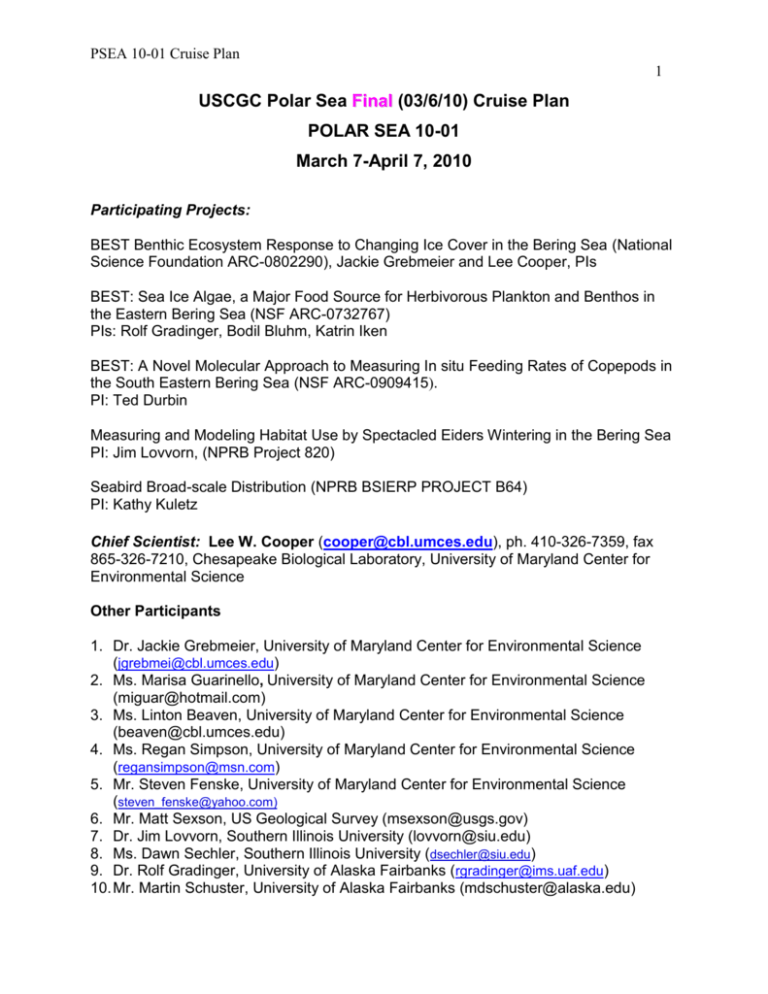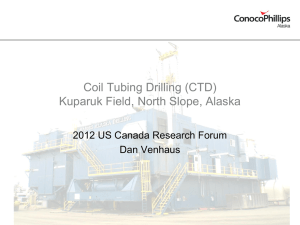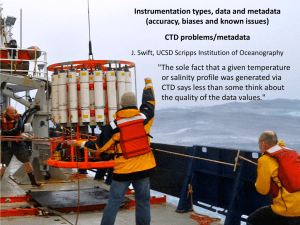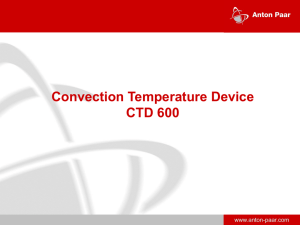PSEA 10-01Cruise Plan
advertisement

PSEA 10-01 Cruise Plan 1 USCGC Polar Sea Final (03/6/10) Cruise Plan POLAR SEA 10-01 March 7-April 7, 2010 Participating Projects: BEST Benthic Ecosystem Response to Changing Ice Cover in the Bering Sea (National Science Foundation ARC-0802290), Jackie Grebmeier and Lee Cooper, PIs BEST: Sea Ice Algae, a Major Food Source for Herbivorous Plankton and Benthos in the Eastern Bering Sea (NSF ARC-0732767) PIs: Rolf Gradinger, Bodil Bluhm, Katrin Iken BEST: A Novel Molecular Approach to Measuring In situ Feeding Rates of Copepods in the South Eastern Bering Sea (NSF ARC-0909415). PI: Ted Durbin Measuring and Modeling Habitat Use by Spectacled Eiders Wintering in the Bering Sea PI: Jim Lovvorn, (NPRB Project 820) Seabird Broad-scale Distribution (NPRB BSIERP PROJECT B64) PI: Kathy Kuletz Chief Scientist: Lee W. Cooper (cooper@cbl.umces.edu), ph. 410-326-7359, fax 865-326-7210, Chesapeake Biological Laboratory, University of Maryland Center for Environmental Science Other Participants 1. Dr. Jackie Grebmeier, University of Maryland Center for Environmental Science (jgrebmei@cbl.umces.edu) 2. Ms. Marisa Guarinello, University of Maryland Center for Environmental Science (miguar@hotmail.com) 3. Ms. Linton Beaven, University of Maryland Center for Environmental Science (beaven@cbl.umces.edu) 4. Ms. Regan Simpson, University of Maryland Center for Environmental Science (regansimpson@msn.com) 5. Mr. Steven Fenske, University of Maryland Center for Environmental Science (steven_fenske@yahoo.com) 6. Mr. Matt Sexson, US Geological Survey (msexson@usgs.gov) 7. Dr. Jim Lovvorn, Southern Illinois University (lovvorn@siu.edu) 8. Ms. Dawn Sechler, Southern Illinois University (dsechler@siu.edu) 9. Dr. Rolf Gradinger, University of Alaska Fairbanks (rgradinger@ims.uaf.edu) 10. Mr. Martin Schuster, University of Alaska Fairbanks (mdschuster@alaska.edu) PSEA 10-01 Cruise Plan 2 11. Mr. Jared Weems, University of Alaska Fairbanks (ftjdw@uaf.edu) 12. Dr. Kathy Kuletz, US Fish and Wildlife Service (Kathy_Kuletz@fws.gov) 13. Mr. Aaron Lang, US Fish and Wildlife Service (birdingak@gmail.com) 14. Mr. Scott Hiller, Scripps Institution of Oceanography (shiller@ucsd.edu) 15. Mr. Ben Gire, Scripps Institution of Oceanography (bgire@ucsd edu) 16. Dr. Ed Durbin, University of Rhode Island (edurbin@gso.uri.edu) 17. Ms. Maria Casas, Univrsity of Rhode Island (mcasas@gso.uri.edu) 18. Ms. Sigrid Salo, National Oceanic and Atmospheric Administration (Sigrid.a.salo@noaa.gov) 19. Mr. Peter Proctor, National National Oceanic and Atmospheric Administration (Peter.proctor@noaa.gov) 20. Dr. Didier Burdloff, Lamont Doherty Earth Observatory of Columbia University (budloff@ldeo.columbia.edu 21. Mr. Mark Bradford*, University Corporation for Atmospheric Research (mark@ucar.edu) 22. Mr. John Allison*, University Corporation for Atmospheric Research (jja@ucar.edu) *Bradford and Allison will swap out with each other, transferring at Gambell or Savoonga Space is also being held for two potential media representatives, who will board from and disembark to St. Lawrence Island. A. CRUISE SCIENCE OVERVIEW Patch dynamics is a conceptual approach to ecosystem and habitat analysis that emphasizes the dynamics of heterogeneity within a system. Benthic-oriented measurements have been taken in the northern Bering Sea for many years because the region is known to support highly productive benthic communities and food resources for benthic-feeding apex predators, including gray whales, bearded seals, walruses, and diving sea-ducks—all of which are important for subsistence hunting by local Bering Sea communities. Continued benthic sampling is planned in the St. Lawrence Island area to complement the planned documentation of walrus distributions from the bridge and helicopter surveys that will also identify foraging areas for wintering spectacled eiders. Recent studies (e.g. Grebmeier et al. 2006; Science 10 March 2006: Vol. 311. no. 5766, pp. 1461 - 1464) suggested that climate warming may change the present benthic-dominated northern Bering Sea ecosystem to one more pelagic in nature, similar to the southern Bering Sea—a direct result of changing trophic interactions. Specific evaluation of dominant infaunal prey of walrus (e.g., bivalves, gastropods, and polychaetes), will be undertaken during the benthic field component of this BSIERPBEST walrus-prey patch dynamics study. We will plan to place these studies in the context of retrospective benthic data sets collected over the last 20 years in the region. We will be evaluating the spatial heterogeneity of benthic infaunal population and sediment tracers in oceanographic context at coarse scales (20 nm) to evaluate overall effects on ecological processes. We will also strive to develop scaling strategies and limitations for extrapolating information from the small scale (3-5 nm) used for our walrus-prey patch dynamics study to larger (10-20 nm) and even regional (50-100 nm) scales in order to evaluate information from the local ecosystem to overall northern Bering Sea regional scale in which the walrus reside. B. FIELD SAMPLING PSEA 10-01 Cruise Plan 3 OVERVIEW OF POLAR SEA 2010 FIELD SAMPLING This prey patch dynamics study jointly funded by the National Science Foundation (BEST) and the North Pacific Research Board (BSIERP) will primarily evaluate the iceoceanographic ecosystem supporting a highly productive benthic prey field for walrus and spectacled eider predation. The core sampling at each station will include a CTD deployment (technical support provided through NSF agreement with Scripps Institution of Oceanography), water column collections to document the chlorophyll, nutrients and stable oxygen-18/oxygen-16 distributions, carbon supply to the sediments (using sediment respiration incubations) and benthic measurement of in-faunal populations (van Veen grabs). Towards the end of the cruise, water column sampling along the 70 m isobath of the Bering Shelf southward towards the Aleutians will be undertaken at relatively high density as part of physical oceanographic program embedded in the Bering Sea research program supported through BEST and BSIERP. Prior to that sampling, a total of 30-40 benthic stations will be occupied, and at least once per day the ship will be positioned so that nearby sea ice can be sampled by the Gradinger et al, Sambrotto, and National Ice Center research group from the starboard side. Ideally these on-ice deployments will occur while aft and port sampling are simultaneously underway. Access to the ice will be ideally from the ship crane or brow although use of small boats and the helicopter might be necessary under some conditions. The Lovvorn efforts relating to wintering spectacled eiders will be coordinated with helicopter needs identified by the Gradinger et al. group to recover sediment traps left within the ice. The spectacled eider research efforts include both surveying and specimen collection efforts. The Kuletz et al. led bird and marine mammal observer program will be based on the bridge and will be underway when the ship is transiting. The following schedule is tentative for this cruise, with the ship sampling time in draft form until at sea. Sampling locations are shown on Figure 1 and coordinates are tabulated in Table 1. Changes in this station sequence are likely as a result of ice conditions and walrus distributions. We will also pick some additional tighterscale benthic sampling stations that will be dictated by walrus distributions March 7, 09:00, Ship departs Kodiak March 8-14: Transit to North Bering Sea sampling area (Figure 1). March 15-16 Location of spectacled eider flocks and alteration of ship track as necessary; initial benthic sampling (VNG1 and NWC5) March 17-18: Sampling moves northeast toward St. Lawrence Island on the SWC and NWC lines: NWC4, SWC4, SWC4A, VNG3.5 (4 stations) March 19-20: VNG3, NWC4A, CD1, VNG4, NWC3, (5 stations) March 21-22: DLN3, DLN2, NWC2.5, NWC2, VNG5, (5 stations) March 23-24: SWC2, SIL1, SEC1, SEC2, SEC2.5, (5 stations) March 25-26: POP3A, SIL3, POP4, SEC3, (4 stations) March 27-28: NEC2.5, NEC1, NEC2, NEC3 (4 stations) March 29-April 2: Occupation of 70 m isobath along Bering Shelf; baseline nutrient sampling near Nunivak Island April 3-7 Transit to Kodiak PSEA 10-01 Cruise Plan 4 April 7, 09:00,Healy docks at City dock, Kodiak PSEA 10-01 Cruise Plan 5 Figure 2. Station names for St. Lawrence Island polynya region including initial 70 m isobath stations. PSEA 10-01 Cruise Plan 6 Figure 3. Overview of overall sampling plan, including 70 m isobath stations to be occupied at end of cruise. Table 1. Draft plan for intended movement of Polar Sea during PSEA10-01, March 7April 7, 2010. PSEA 10-01 Cruise Plan 7 Station Name Latitutde (°N) Longitude (°W) VNG1 NWC5 NWC4 SWC4 SWC4A VNG3.5 VNG3 NWC4A CD1 VNG4 NWC3 DLN3 DLN2 NWC2.5 NWC2 VNG5 SWC2 SIL1 SEC1 SEC2 SEC2.5 POP3A SIL3 POP4 SEC3 NEC2.5 NEC1 NEC2 NEC3 62.0183 62.0562 62.3876 62.2414 62.4124 62.5687 62.5528 62.5606 62.6741 62.7498 62.7799 62.8990 63.2708 63.0298 63.1148 62.9665 62.9141 63.0953 62.9915 62.6060 62.4967 62.5678 62.4383 62.4003 62.2808 62.4728 62.7551 62.4272 62.0569 -175.0622 -175.1991 -174.5503 -173.7408 -173.4359 -173.5721 -173.8429 -174.1848 -173.362 -173.4072 -173.8768 -174.5856 -173.7448 -173.4423 -173.1350 -172.9851 -172.2867 -171.2921 -170.2677 -170.9483 -171.8469 -172.2941 -172.3106 -172.6906 -171.5641 -170.9581 -169.5866 -170.0591 -170.6288 Depth (m) 67 80 70 56 55 60 62 64 60 61 68 77 74 65 72 60 50 50 40 37 42 43 48 60 47 42 49 30 35 PSEA 10-01 Cruise Plan 8 Sta Name Activity M8 ctd 62 M8 Checking on whether they actually plan to do this m8-S 70M56 70M55 70M54 70M53 70M52 70M51 70M50 70M49 70M48 70M47 70M46 70M45 70M44 70M43 70M42 70M41 70M40 70M39 M5W 70m38/ M5 moorings3 pickups &2 deployed 70m38M5 ctd 70M37 70M36 70M35 70M34 70M33 70M32 70M31 70M30 70M29 ctd ctd ctd ctd ctd ctd ctd ctd ctd Lat. H Long 12 N 174 45 W 62 11.64 N 174 44 W 0.60 1.1 ctd ctd ctd ctd ctd ctd ctd ctd ctd ctd ctd ctd ctd ctd ctd ctd ctd ctd ctd 61 62 61 61 61 61 61 61 61 60 60 60 60 60 60 60 59 59 59 58.5 1.590 56.600 51.730 43.640 33.610 24.640 14.990 3.940 54.440 44.330 34.310 25.500 15.100 6.030 2.230 58.690 54.690 53.88 N N N N N N N N N N N N N N N N N N N 174 174 174 174 173 173 173 173 173 173 173 173 173 173 173 173 172 172 172 37.02 39.520 21.850 5.656 51.280 42.730 44.170 44.450 49.760 49.480 38.880 38.370 35.500 31.300 19.000 0.390 44.770 26.110 10.00 W W W W W W W W W W W W W W W W W W W 14.02 3.32 9.69 9.06 10.57 10.83 9.01 9.66 11.35 9.51 11.36 10.03 8.93 10.62 10.95 10.04 8.58 10.18 8.13 25.6 6.1 17.7 16.5 19.3 19.8 16.4 17.6 20.7 17.4 20.7 18.3 16.3 19.4 20.0 18.3 15.7 18.6 14.8 FYI 59 53.5 N 171 42.660 W 13.73 25.1 1.09 2.0 11.14 10.08 9.78 9.58 9.74 9.17 9.84 9.84 10.50 20.3 18.4 17.9 17.5 17.8 16.7 18.0 18.0 19.2 59 59 59 59 59 59 59 59 58 58 lat-min 54.578 46.620 42.930 35.700 26.140 20.120 14.820 6.410 56.900 46.460 N N N N N N N N N N 171 171 171 170 170 170 170 170 170 170 lonmin H 42.472 26.980 8.390 55.370 54.360 39.350 24.730 14.810 19.640 17.620 W W W W W W W W W W Dist. (nm) Dist. (km) PSEA 10-01 Cruise Plan 9 70M28 70M27 70M26 70M25 70M24 70M23 70m22 M4W 70M21 M4go1 mi away ctd ctd ctd ctd ctd ctd ctd 58 58 58 58 58 57 57 37.020 26.770 16.920 8.830 2.530 54.420 46.00 N N N N N N N 170 170 170 169 169 169 169 16.530 11.140 5.680 55.090 40.350 30.000 12.00 W W W W W W W 9.47 10.64 10.27 9.84 10.03 9.80 12.77 17.3 19.4 18.7 18.0 18.3 17.9 23.3 FYI 57 51.120 N 168 53.201 W 11.26 20.5 70M21/M4 ctd 57 50.000 N 168 53.201 W 1.13 2.1 70m19-M4S ctd 57 36.00 N 168 42.00 W 15.23 27.8 70M18 70M17 70M16 70M15 70M14 70M13 70M12 70M11 70M10 70M9 70M8 70M7 70M6 70M5 70M4 70M3 70M2/M2 ctd ctd ctd ctd ctd ctd ctd ctd ctd ctd ctd ctd ctd ctd ctd ctd ctd 57 57 57 57 57 57 57 57 57 57 57 57 56 56 56 56 56 31.440 31.210 30.040 30.070 29.960 31.340 25.720 26.280 19.340 19.260 15.730 6.400 59.610 51.540 54.560 48.5 54 N N N N N N N N N N N N N N N N N 168 168 167 167 167 167 166 166 166 166 165 165 165 165 164 164 164 36.810 18.240 59.170 39.910 20.650 2.290 48.720 30.750 19.580 0.670 44.830 36.800 22.650 7.370 49.650 35 3.000 W W W W W W W W W W W W W W W W W 5.35 9.98 10.32 10.36 10.36 9.97 9.22 9.70 9.20 10.22 9.27 10.30 10.27 11.61 10.15 10.05 18.35 9.8 18.2 18.8 18.9 18.9 18.2 16.8 17.7 16.8 18.7 16.9 18.8 18.7 21.2 18.5 18.3 33.5 70M2/M2 mooring site-FYI 56 52.600 N 164 3.400 W 1.43 2.6 CTD -M2S ctd 56 40.00 N 163 52.00 W 14.07 25.7 CN3 CN4 CN5/ M2 CN6 CN7 CN8 CN9 CN10 CN11 CN12 CN13 CN14 CN16 ctd ctd ctd ctd ctd ctd ctd ctd ctd ctd ctd ctd ctd 57 57 56 56 56 56 56 56 55 55 55 55 55 22.992 7.830 53.922 42.300 33.840 25.320 16.680 8.220 59.220 51.060 42.000 33.250 24.300 N N N N N N N N N N N N N 163 163 164 164 164 165 165 166 166 166 167 167 168 31.680 47.820 2.292 30.540 54.300 18.180 42.060 6.240 30.600 54.420 18.240 42.400 0.000 W W W W W W W W W W W W W 44.40 17.51 15.99 19.36 15.58 15.71 15.81 15.90 16.32 15.65 16.18 16.22 13.41 81.0 31.9 29.2 35.3 28.4 28.7 28.9 29.0 29.8 28.6 29.5 29.6 24.5 PSEA 10-01 Cruise Plan 10 NOTE: There are two moorings in our study area that should be surrounded by a “DO NOT GET CLOSER THAN 5 MILES CIRCLE”: Location in 2009 (seeking updated information for 2010): 1. 06BS-8 Mooring (Top Instrument at 22 meters), 62° 11.6334'N/ 174° 40.0587'W 2. 06BSP-8 (ADCP at 60 meters), 62° 11.727'N/ 174° 39.591'W C. FIELD OPERATIONS AND ORDER OF SAMPLING FOR A GENERIC STATION Position ship if possible to facilitate deployment of teams on ice from the starboard side of the ship (~once daily, daylight conditions; possibly more than once daily if requested) Port and aft shipboard operations underway if possible while ice teams are deployed Helicopter operations interspersed, daylight hours CTD deployment from port winch (T/S, chlorophyll, nutrients, O-18, bottom water for respiration cores), Net collections using dual bongo zooplankton net from stern or port side Benthic collections (5-7 van Veen grabs, 2 HAPs multi-corer deployments). Recover ice teams from sea ice to ship Transit to next station APPENDICES FOR COLLABORATIVE PROJECTS ONBOARD PSEA 10-01 APPENDIX A Gradinger et al. The primary goals of our study are to determine the biomass, diversity, production and fate of ice algae in the BEST study area. This task will be accomplished by a combination of physical, chemical and biological field measurements during ship expeditions, combined with experimental studies. During this expedition we specifically want to: (1) measure chemical (nutrients, salinity) and physical parameters (ice thickness, snow depth, ice temperature, light) of sea ice and the under-ice water layer; (2) describe and quantify the temporal and spatial variability of ice algal parameters (algal pigments, taxonomic composition, size spectra, POC, PON, 13C ratio) over a range of relevant ice characteristics and other physical and chemical gradients observed in the study area; (3) quantify the primary production of ice algae (using labeled precursors); (4) quantify the same parameters as in objectives (1) and (2) for the phytoplankton immediately under the sea ice (scale of cm to meters) and quantify algal pigments and 13C stable isotope ratios; (5) determine characteristics of sedimenting particles (species/particle type, algal pigments, PON, POC, 13C and 15N) by deploying drifting short term (<24hours) sediment traps under Bering Sea ice; (6) determine stable isotope composition (13C, 5N) in selected zooplankton and benthic taxa including surface sediments in addition to the isotopic measurements on ice algae, phytoplankton and sedimenting material mentioned above; (7) conduct on-board feeding experiments with isotopically enriched food and a benthic feeder (bivalve) to PSEA 10-01 Cruise Plan 11 assess the importance of two isotopically different end-members (ice POM, pelagic POM)by applying mixing models. We propose to use the following sampling approach to be modified based on time/station availability: Ice and water samples will be taken during on-ice deployments per station, and water and benthic samples by net and grab hauls, respectively, will be sampled from the vessel. All modes of operation described below have successfully been used by the PIs during Arctic expeditions in 2002, 2004, 2005 and 2008 onboard the icebreaker Healy. While on station, sampling will be done from a suitable ice floe along the side of the ship. We expect that ice deployments of personnel (3-4 people) and gear will occur at the lee-side of the ship over the brow; a GC polar bear watch will be needed. Small boat operations and helicopters may be needed to reach additional ice floes or when no suitable ice floes are nearby the selected station location. The ice floe will be selected to represent the typical ice condition range observed for that station in terms of floe size, snow depth and ice thickness based on the standard ice observations. Each floe will be sampled for a main sampling station (CTD, H2O, sediment traps, UW video, ice cores) and two satellite locations per ice floe approximately 50 m away from the main sampling location (ice cores only). An ice auger will be used to drill holes for CTD, water sampling and for sediment trap and in-situ primary production experiment deployment. Primary production measurements will be done with 4 h in-situ incubations. Temperature, salinity, light (PAR range) and chlorophyll fluorescence of the upper water column (upper 30m) will be determined with a SEACAT 19plus CTD lowered by hand through an auger hole in the ice at the main sampling station. A simultaneous 2π sensor reading (LICOR instruments) at the ice surface will provide a reference for the light readings. These readings will occur away from the ship’s influence and will provide information unbiased by ship movement on the near-surface hydrography in the BEST region and help detect near-surface under-ice phytoplankton blooms. We propose to deploy small sediment traps (diameter 10 cm, aspect ratio 1:10, filled with 0.2μm filtered sea water) through holes at the main sampling location for a minimum of 5 h, ideally 12 h. Approximately seven ice cores will be taken per sampling location, cores sliced and sections individually bagged to assess Chl a, POC, PON, stable isotope ratios, and NO2, NO3, SiO4, PO4 concentrations. Once ice activities are completed, all personnel and gear will be brought back on board. Sediment traps may remain deployed to achieve minimum deployment time, and two scientists may return onto the ice to retrieve the traps later. Alternatively, traps can be recovered via helicopter. We request 2L from the Chl max depth water depths from the CTD for water POM characterization. If Chl max depth is poorly defined, we anticipate taking water from approximately 15 m depth. A suite of ca. 5 zooplankton species occurring throughout the study area will be sampled at each station using the bongo net. We will have a back-up 50 cm ring diameter 200 μm mesh plankton net. Benthic sediment and common benthic primary consumers will be collected using 2-3 replicate Van Veen grabs (0.1m2, one replicate can be shared with Dr. Jackie Grebmeier by using her nonquantitative grab sample). Small sub-samples of surface sediment will be taken for benthic chlorophyll and stable isotope measurements with syringe corers before the grab is opened, and samples will be stored frozen until further processing. Remaining PSEA 10-01 Cruise Plan 12 grab samples will be sieved immediately over 1mm mesh and 4-5 benthic target species selected as representatives of the benthic food web. Request for support from USCGC POLAR SEA: - Polar bear guard - 2 sleds for on-ice work - transport to/from sea ice (crane/helicopter/small boat, brow) - freezer space: -80 deg C freezer (for pigments/lipids), -30 deg C freezer (for water samples), Participants: 3 (Gradinger, Schuster, Weems) APPENDIX B. Seabird Observations: Kathy Kuletz, US Fish and Wildlife Service, Anchorage, AK; The U. S. Fish and Wildlife Service (USFWS) is undertaking an at-sea program utilizing ships of opportunity, with the goal to update our seabird database and improve efforts to use them as indicators of change in the North Pacific/Arctic oceans. Two seabird observers are scheduled to be onboard PolarSEA to take advantage of oceanographic and biological data in relation to seabird distribution and abundance. The USFWS seabird observers will be equipped with all necessary field gear, including a laptop computer with integrated GPS for data recording. Following established protocols, the observers will conduct surveys during daylight hours, recording all marine birds and mammals within a set transect width. Participants: 2 APPENDIX D. BEST: A novel molecular approach to measuring In situ feeding rates of copepods in the South Eastern Bering Sea. General Mesozooplankton play a critical role in determining carbon flow from primary producers to higher trophic levels. In the SE Bering Sea interannual changes in the timing and extent of both sea ice cover and summer stratification will affect their role in determining the path of carbon flow, whether through the pelagic ecosystem or to the benthos. Knowledge of the actual in situ mesozooplankton diet composition and ingestion rates is essential to understanding the flow of carbon in this system. Information about these rates using traditional bottle incubation techniques when sea ice cover is present will be compromised because of the strong vertical gradients in the mesozooplankton prey environment making sampling the appropriate prey field difficult. The PIs will carry out a field investigation of in situ feeding rates by copepods on the Bering shelf during spring when sea ice is present. For this they will use a novel molecular technique they have developed to quantitatively measure ingestion rates on different prey species from zooplankton stomach content analysis. They will use the 18S ribosomal RNA gene as a marker to identify different prey species present in the guts of copepods and quantitative real-time polymerase chain reaction (q-PCR) to measure copy number of this gene for each prey species. Ingestion rates will be PSEA 10-01 Cruise Plan 13 calculated from this gut content information, 18S copy number/organism, and DNA digestion rates. By combining these in situ ingestion rate measurements with zooplankton abundance measurements and the prey field composition, they will be able to determine the fate of phytoplankton production under the varying environmental conditions. In addition, since little is known of the development of abundant copepods such as Calanus glacialis in this region during early spring, the PIs will collect samples to determine the abundance of different developmental stages of these dominant copepods. Station Activities The station plan indicates that several stations per day will be sampled in the intensive sampling area. The PIs would probably only sample at two of these. Since zooplankton usually show diel feeding periodicity, even if they are not undergoing diel vertical migration, the PIs would like to make some of their collections for feeding rate measurements during the early evening hours. They would like to sample during the 70 m isobath transect on the return to Kodiak to provide larger spatial scale information on zooplankton abundance and stage distribution, and on zooplankton feeding. At each station that they sample their activities will be: 1. Collect 4 l of water from the surface and the chlorophyll max (15 m if no chlorophyll max present) from CTD niskin bottles. Water for phytoplankton DNA will be filtered and frozen at -80°C. Water for microscopic species identification will be concentrated and preserved with Lugols iodine. 2. Make a vertical tow with a 0.5 m diam 64 µm mesh ring net from near the bottom to the surface. This will be preserved in formalin for identification and enumeration of smaller zooplankton and determination of developmental stages of abundant copepods such as Calanus glacialis. 3. Make a vertical tow with a 60 cm bongo from near the bottom to the surface. This will be preserved in formalin for larger zooplankton identification and enumeration. Both of these nets will be deployed so that they only sample during the upward tow. 4. Make a vertical tow with a 1 m diam 150 µm mesh ring net to about 30 m to collect zooplankton for gut DNA characterization and gut pigment determination. This is non-quantitative and the net will sample on both the down and up portions of the tow. A portion of the cod-end will be immediately fixed in ethanol for gut DNA. A second portion will be anesthetized with MS222 and adults or older copepodid stages of abundant copepods sorted for gut pigment determination. 5. At selected stations we will isolate phytoplankton cells to establish cultures of species of interest. PSEA 10-01 Cruise Plan 14 APPENDIX E. Measuring and modeling habitat use by Spectacled Eiders wintering in the Bering Sea, Jim Lovvorn, University of Wyoming In 2007, the North Pacific Fishery Management Council established the Northern Bering Sea Research Area, which is closed to bottom trawling until a fishery management plan is developed. Areas must be identified for protecting marine mammals, threatened species, snow crabs, and Native subsistence, followed by research in remaining areas to assess possible effects of bottom trawling. Between St. Matthew and St. Lawrence Islands, the principal threatened species is the Spectacled Eider (SPEI), whose world population winters there. The eiders’ dispersion was consistent in the 5 years they were located between 1996 and 2001; however, a limited search in 2006 suggested that their distribution has changed. Such shifts would alter current perceptions of viable habitat for SPEI, and modify delineation of areas to be protected. Such delineations might also be influenced by population trends. In conjunction with walrus surveys funded by NSF BEST and NPRB BSIERP, we propose to characterize the current dispersion of SPEI from ships’ helicopters, and count the population from fixed-wing aircraft. Eider dispersion will be compared with recent and concurrent surveys of benthic prey, and used to test and refine a model that predicts where eiders can maintain positive energy balance. This model will indicate how the location and extent of SPEI habitat has changed over 35 years, and how possible future changes can be considered in fishery management plans.




